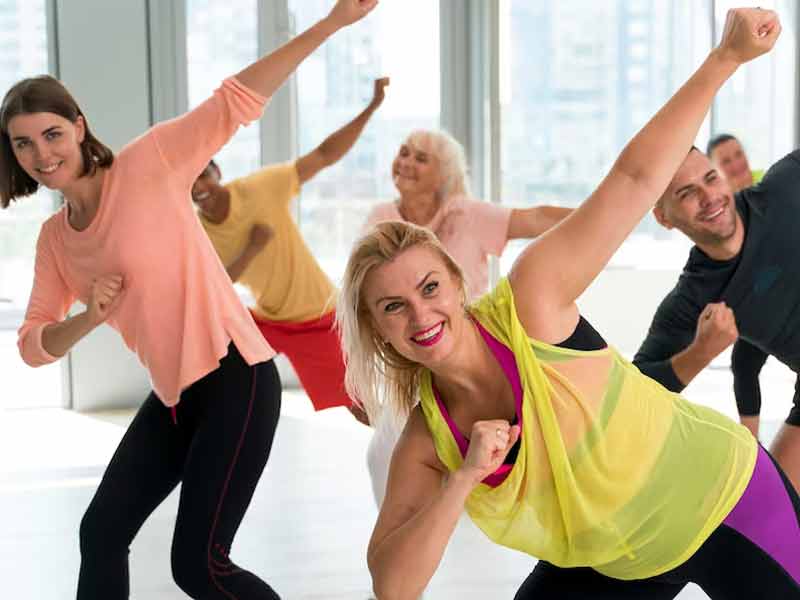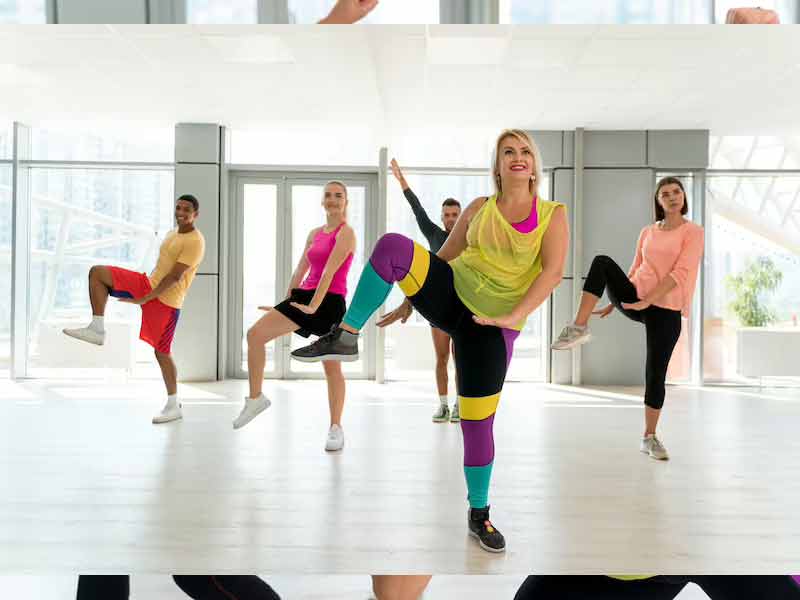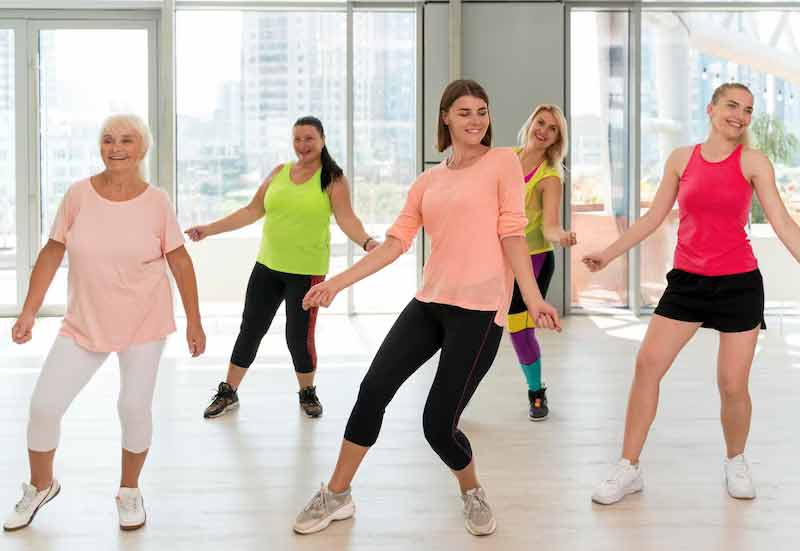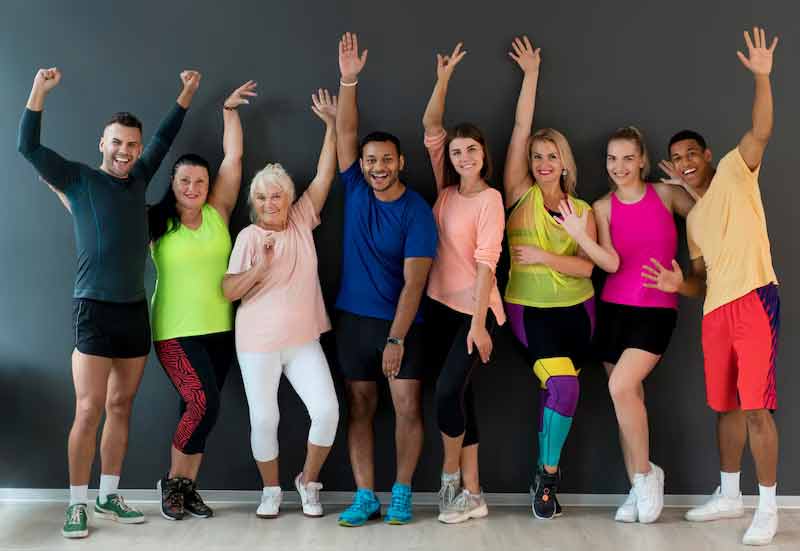Dancing is an excellent way to start your day with a burst of energy and a positive mood. It is a fun and creative form of exercise that can be done alone or with friends and family, and it has numerous health and fitness benefits.
Why dancing is one of the best workouts for the morning ?
In this article, we’ll explore the reasons why dance is one of the best workouts for the morning, and how you can incorporate it into your daily routine.
Boosts Energy Levels

Dancing in the morning is an excellent way to wake up your body and mind and get your energy flowing. It increases your heart rate, breathing rate, and blood flow, which helps to deliver more oxygen and nutrients to your muscles and brain. This, in turn, can help you feel more alert, focused, and energized throughout the day.
Improves Mood

Dancing is a mood-boosting activity that can help to reduce stress, anxiety, and depression. It releases endorphins, which are natural chemicals in the body that promote feelings of pleasure and happiness. It also allows you to express yourself creatively, which can be a great way to relieve pent-up emotions and connect with your inner self.
Increases Cardiovascular Health with dancing
Dancing is a great cardiovascular workout that can improve your heart health and reduce the risk of chronic diseases like heart disease and stroke. It can help to lower blood pressure, improve cholesterol levels, and increase the efficiency of your heart and lungs.

Regular dancing can also help to improve your endurance, which can be useful in other forms of exercise.
Builds Strength and Flexibility with dancing

Dancing is a full-body workout that engages your muscles from head to toe. It can help to tone and strengthen your muscles, especially in your legs, core, and arms. It can also improve your flexibility, balance, and coordination, which can be useful in other physical activities like sports and exercise classes.
Burns Calories with dancing
Dancing is a great way to burn calories and lose weight. Depending on the type of dance and the intensity level, you can burn anywhere from 200 to 500 calories per hour. This makes it an excellent option for those who want to improve their fitness and lose weight, without having to go to the gym or follow a strict diet.
How to Incorporate Dancing into Your Morning Routine ?
Incorporating dance into your morning routine is easy and fun. Here are some tips on how to get started:
Choose Your Music
Choose a playlist of upbeat and energetic music that you enjoy and that gets you moving. You can choose from a variety of genres, including pop, hip-hop, Latin, and more.
Clear Some Space
Clear a space in your home where you can dance freely without any obstacles. Make sure there is enough room to move around and that the area is safe and free from any hazards. Complete cycling training with 30 golden tips
Warm Up
Before you start dancing, it’s important to warm up your body and prevent any injuries. You can do some light stretches, like touching your toes, reaching for the sky, and twisting your torso. You can also do some jumping jacks or jog in place to get your heart rate up.
Start Dancing
Once you’re warmed up and ready to go, start dancing to your music. You can do any type of dance that you enjoy, whether it’s freestyle, hip-hop, salsa, or anything in between. You can also follow along to dance tutorials on YouTube or join a dance class in your community.
Cool Down
After you’re done dancing, it’s important to cool down and stretch your muscles to prevent soreness and tightness. You can do some light stretches, like bending your knees, reaching for your toes, and stretching your arms overhead. Complete jogging training with 30 golden tips
The types of dancing for exercise
Dance is a wonderful way to get exercise while also having fun and expressing yourself creatively. There are many different types of dance that can be used as an exercise routine, each with its own benefits and unique characteristics.

In this article, we will explore some of the most popular types of dance for exercise.
Zumba
Zumba is a Latin-inspired dance fitness program that was created in the 1990s. It combines fast-paced, high-energy dance moves with upbeat music to create a fun and effective workout. Zumba is known for its ability to burn calories and improve cardiovascular health, as well as its ability to improve coordination and balance.
Ballet
Ballet is a classical dance form that originated in the Renaissance courts of Italy and France in the 15th century. Ballet is known for its grace, elegance, and precision, and it can be a challenging and rewarding form of exercise. Ballet can improve flexibility, balance, and strength, and it can also help to improve posture and body awareness.
Hip Hop
Hip hop is a street dance style that originated in the African American and Latino communities in the United States in the 1970s. Hip hop is known for its high-energy moves and its emphasis on individuality and self-expression. Hip hop can be a great way to improve cardiovascular health and endurance, as well as coordination and rhythm.
Jazz
Jazz dance is a style of dance that originated in the United States in the early 20th century. Jazz dance is known for its improvisation and its emphasis on individual style and expression. Jazz dance can be a great way to improve cardiovascular health and endurance, as well as flexibility, coordination, and balance.
Tap
Tap dance is a style of dance that involves using the feet to create rhythmic sounds and beats. Tap dance originated in the United States in the mid-19th century, and it remains a popular form of dance today. Tap dance can be a great way to improve cardiovascular health and endurance, as well as coordination and rhythm.
Salsa
Salsa is a Latin dance style that originated in Cuba in the 1940s. Salsa is known for its fast-paced, rhythmic moves and its emphasis on partner work and social dancing. Salsa can be a great way to improve cardiovascular health and endurance, as well as coordination and balance.
Bollywood
Bollywood dance is a style of dance that originated in the Indian film industry in the 1930s. Bollywood dance is known for its energetic moves and its use of storytelling and expression. Bollywood dance can be a great way to improve cardiovascular health and endurance, as well as flexibility, coordination, and balance.
Belly Dance
Belly dance is a dance style that originated in the Middle East and North Africa. Belly dance is known for its emphasis on fluid movements and its use of the abdominal muscles. Belly dance can be a great way to improve flexibility, balance, and posture, as well as to strengthen the abdominal muscles.
Pole Dancing
Pole dancing is a form of dance that involves performing acrobatic moves on a vertical pole. Pole dancing has gained popularity in recent years as a form of exercise, and it can be a great way to improve upper body strength, flexibility, and coordination.
Line Dancing
Line dancing is a type of dance in which a group of people dance together in lines or rows. Line dancing is known for its simplicity and accessibility, and it can be a great way to improve cardiovascular health and endurance, as well as coordination and rhythm.
Classical dancing and a Latin-inspired dancing

Classical dancing and Latin-inspired dancing are two distinct styles of dance that have their roots in different parts of the world and have unique cultural and historical significance. While both styles of dance require precision, skill, and technical ability, there are several key differences between the two. In this article, we’ll explore these differences in more detail.
Classical Dancing
Classical dance refers to a style of dance that has its roots in Western Europe, particularly France and Italy. It is typically characterized by its formal, precise movements, and its emphasis on technique and form. Classical dance encompasses several sub-genres, including ballet, contemporary dance, and modern dance.
One of the key features of classical dancing is the use of pointe shoes, which allow dancers to dance on the tips of their toes. This requires a significant amount of strength and training, and is a hallmark of the classical ballet style. Other key features of classical dance include the use of turnout, which is the outward rotation of the legs from the hip joint, and the use of leaps and turns.
Classical dance is often performed to classical music, such as the works of composers like Tchaikovsky, Beethoven, and Mozart. It is also known for its elaborate costumes and sets, which are often designed to transport the audience to another time or place. Many classical dance productions, such as ballets, tell a story or follow a narrative arc, and may feature a large cast of dancers.
Latin-Inspired Dancing
Latin-inspired dancing refers to a broad range of dance styles that have their roots in Latin America and the Caribbean. These styles are known for their energy, sensuality, and infectious rhythms, and are often associated with social dance and party culture. Some of the most popular styles of Latin-inspired dance include salsa, bachata, merengue, and cha-cha.
One of the key features of Latin-inspired dance is the use of rhythm and beat to drive the movement. Dancers often move their hips, shoulders, and feet in sync with the music, and may incorporate elements of improvisation and partner work. Latin-inspired dance is often performed to lively, upbeat music, such as salsa or samba, and may be accompanied by live percussion or other instruments.
Another key feature of Latin-inspired dancing is its emphasis on social interaction and community. Many Latin-inspired dance styles, such as salsa and bachata, are designed to be danced with a partner, and may involve close physical contact and intimate movements. These dances often take place in social settings, such as nightclubs or dance halls, and are enjoyed by people of all ages and backgrounds.
Differences Between Classical Dancing and Latin-Inspired Dancing

Now that we’ve explored the key features of classical dance and Latin-inspired dance, let’s take a closer look at the differences between the two.
Style and Movement
One of the most obvious differences between classical dance and Latin-inspired dancing is the style and movement. Classical dancing is known for its precise, formal movements, while Latin-inspired dance is known for its energy, rhythm, and improvisation. Classical dancers often move with a sense of control and restraint, while Latin dancers move with a sense of freedom and abandon.
Music
Another key difference between classical dancing and Latin-inspired dancing is the music. Classical dance is typically performed to classical music, which is often complex and highly structured. Latin-inspired dancing, on the other hand, is often performed to popular music, which is characterized by its strong rhythms and upbeat tempo. The music of Latin-inspired dance is often accompanied by live percussion or other instruments, which add to the sense of energy and excitement.
Emphasis on Narrative
Classical dancing is often performed as part of a larger production, such as a ballet or opera. These productions typically follow a narrative arc and tell a story through dance and music. In contrast, Latin-inspired dance is less focused on narrative and is often more about individual expression and connection with the music and other dancers.
Costumes and Setting
Classical dancing is known for its elaborate costumes and sets, which are often designed to transport the audience to another time or place. The costumes and sets are typically highly detailed and carefully crafted, and add to the overall spectacle of the performance. In contrast, Latin-inspired dance is often performed in more casual settings, such as dance clubs or outdoor festivals, and the costumes and attire are often less formal and more relaxed.
Partner Work
While classical dance may involve partner work, it is typically less common and less emphasized than in Latin-inspired dance. In Latin-inspired dance, partnering is often a key component of the dance style, and dancers may perform intricate lifts, dips, and spins with their partners. This emphasis on partnering and connection is a hallmark of many Latin-inspired dance styles, and adds to the sense of community and social interaction.

In conclusion, while both classical dance and Latin-inspired dance require precision, skill, and technical ability, there are several key differences between the two styles. Classical dance is known for its formal, precise movements, elaborate costumes and sets, and emphasis on technique and form. Latin-inspired dance, on the other hand, is known for its energy, rhythm, improvisation, and emphasis on social interaction and community. Whether you prefer the elegance of classical dance or the exuberance of Latin-inspired dance, both styles offer a unique and rewarding way to express yourself through movement and music.
Conclusion for dancing
There are many different types of dance that can be used as an exercise routine, each with its own benefits and unique characteristics. Whether you prefer a high-energy dance style like hip hop or salsa, or a more classical form like ballet, dancing can be a great way to improve your physical health while also having fun and expressing yourself creatively. It’s important to choose a dancing style that you enjoy and that fits your fitness goals and level of experience. With practice and dedication, dance can help you build strength, improve flexibility, and increase cardiovascular endurance, all while allowing you to express yourself and have fun.

When choosing a dance style, it’s important to consider your fitness level and any physical limitations you may have. Some dancing styles may be more intense or require more physical strength and flexibility than others. For example, tap dance and pole dancing may require more upper body strength and coordination, while ballet and jazz may require more flexibility and balance. It’s also important to find a teacher or instructor who can help you learn the proper technique and form for each dance style.
In addition to the physical benefits of dancing, there are also many mental and emotional benefits to incorporating dance into your exercise routine. Dancing can be a great way to reduce stress, improve mood, and boost self-confidence. It can also help to improve memory and cognitive function, as learning new dance moves requires focus and concentration.
Whether you choose to take a dance class at a studio or gym, or practice at home with online tutorials or videos, dance can be a fun and effective way to get in shape and improve your overall health and well-being. So put on some music, get moving, and enjoy the many benefits of dancing as a form of exercise.
The last word is with you, the audience
Be sure to read other educational articles. For scientific issues, be sure to contact a specialist doctor. These materials are only for study and non-educational purposes. Of course, expert doctors can guide you a lot.
Our cooking training center has collected unique materials for you dear ones. This content is very useful and will help you cook the best and most delicious food for yourself and your loved ones at home.
The recipe section is for introducing the best dishes of the nations. Dear ones, you can see the best dishes in this section and cook whatever you want at home. Don’t forget to read the recipe and ingredients before doing anything to determine your cooking needs.
Soon we will be with you with a more professional team with more facilities. We suggest that if you are overweight, fill out the and wait for our experts to contact you and send you the right meal plan.
The slogan we put on our site is to fight obesity. In this regard, we will provide you with many suitable recipes. Be sure to follow our site to learn about many healthy foods. Do not forget that a healthy life requires extensive changes. One of these changes is changing food. So eat healthy
Please follow us on linkedin. You can learn all best french food recipe and best Italian food recipe and best arabic food recipes and best Iranian food recipes you can check our Reddit page.
